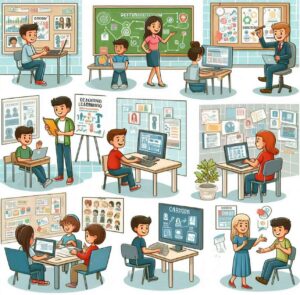Welcome Blessings!
(Tap 🔽 to see more topics!)


Ever feel like you’re talking to a brick wall sometimes? You pour your heart and soul into a lesson, trying to make it crystal clear, but you see a mixed bag when you look out at your class. Some students are nodding along, totally with you. Others look like they’re on a different planet, eyes glazed over. And then there are those speed racers who’ve already finished the assignment before you’ve even finished explaining it! It’s like trying to herd cats; does it ring a bell? Juggling all those different learning styles, abilities, and interests can feel overwhelming. Don’t be surprised; every teacher faces this.
Trying to teach everyone the same way doesn’t work. It’s like trying to fit everyone’s feet into the same pair of shoes. Someone will be pinching, and someone else will be swimming in them. That’s where differentiated instruction comes in. It’s all about recognizing that our students are individuals, each with their own unique needs and strengths.
Think of it like cooking. You wouldn’t serve the same meal to everyone, would you? Some people need extra salt and pepper to bring out the flavor (a little extra support), while others crave something spicier (a more significant challenge). And some folks might have dietary restrictions and need a completely different dish altogether (a different approach to the lesson). Differentiated instruction lets you be the chef, customizing your lessons to nourish every learner in your classroom.
I know what you’re thinking… “That sounds great, but how am I supposed to do that without spending every waking hour prepping?” Don’t worry! It doesn’t have to be as complicated as it sounds. In today’s article, you will learn the four practical, proven strategies to make differentiated instruction work for you without turning your lesson planning into a second full-time job. These tips will make your teaching easier and ignite a love of learning in your students.

(What Students Learn)
A massive part of that is recognizing that every student is different. They don’t all come to us with the same background knowledge or learning styles. That’s why differentiating the content and what students learn is so important. It’s all about making sure each student gets the right level of challenge and the right kind of support to thrive.
Some kids already have a good handle on a topic, while others might need more foundational work before moving on to the more complex stuff. If you teach everyone the same way, you’ll lose some kids because they’re bored and unchallenged or overwhelmed and frustrated. Differentiation is about meeting kids where they are and helping them grow from there. But, how do you do it? There are some efficient strategies you can use:
Think of it like streaming services. Some viewers are ready to binge-watch a complex, advanced series, while others need an introductory episode to get them up to speed. You provide different starting points so everyone can enjoy and get the most out of the learning journey. It’s about making learning accessible and engaging for every student, no matter where they start.

Next is how students learn. It’s not a one-size-fits-all thing. We all know that some people are visual learners, some are hands-on, and others learn best by discussing things. If we only teach in one way, we automatically leave many students behind. It’s like trying to teach everyone to play the piano using only sheet music. Some people will pick it up just fine, but others might learn much better by ear or watch someone else play.
That’s why differentiating the learning process is so important. It’s about recognizing that students have different learning styles and giving them other ways to engage with the material. It is like you’re building a house, and some people learn best by looking at blueprints, others by watching a construction crew, and still others by actually picking up a hammer and getting to work. You need to offer different entry points. How do you do this in the classroom?
Imagine learning to cook. Would you rather watch a tutorial, read a recipe, or jump in and start cooking? Everyone’s different! Some students will thrive with one method, while others will do much better with another. Differentiating the learning process is all about giving them options and letting them find what clicks. It’s not about making extra work for the teacher; it’s about making learning more effective for every student.
Remember, learners are different and show what they know in various ways. Some are excellent writers, others are natural speakers, and some are incredibly creative. Trying to force everyone into the same mold doesn’t work. Imagine how frustrating it is to feel like you’re being judged on something that doesn’t play to your strengths. It’s the same for our students. What can we do about it?
Another thing, imagine you’re applying for a job. Some companies want a traditional resume, while others prefer a portfolio or video introduction. They understand that people shine in different formats. It’s the same with our students. Giving them options makes learning more engaging and gives us a clearer picture of their understanding. It’s about meeting them where they are and letting them shine.
Have you ever walked into a room and just felt…off? You couldn’t quite put your finger on it, but something just wasn’t right. Well, students feel that way about classrooms, too. And just like how your mood impacts your productivity, a student’s environment massively affects learning. If a student feels uncomfortable, unsafe, or just plain bored, even the coolest teacher in the world will have a hard time getting through to them.
That’s where the idea of “differentiating the learning environment” comes in. It’s not some fancy educational jargon. It’s just about making minor tweaks to create a space where every kid feels supported and wants to learn. It’s like making your house feel cozy and inviting, you want everyone to feel at home. The same applies to the classroom.
Now, how do we do this in practice? Below are a few simple things teachers (and even parents helping with homework!) can try:
It’s all about creating a positive vibe. When students feel good in their learning environment, they’re more likely to be engaged, motivated, and successful. And that’s what we all want!

There you have it! Differentiated learning is all about recognizing that every student is unique. It’s like finding the perfect pair of shoes, one size doesn’t fit all! Tweaking what you teach (the content), how you teach it (the process), what students create (the product), and even the classroom vibe (the learning environment), you can create a learning experience that genuinely clicks with each child’s readiness, what excites them, and how they learn best. Imagine the difference it makes when students feel understood and supported… they blossom! They become more engaged, learn more effectively, and enjoy learning.
Want to explore more ways to make differentiated learning work for you? Share your thoughts, experiences, or questions in the comments below. Voila! Until next time!